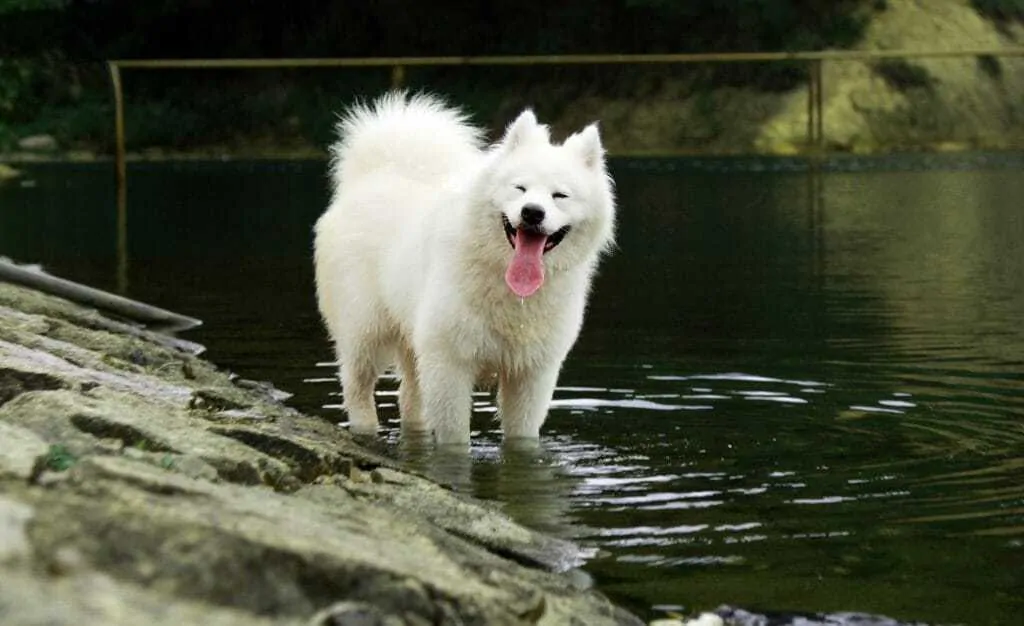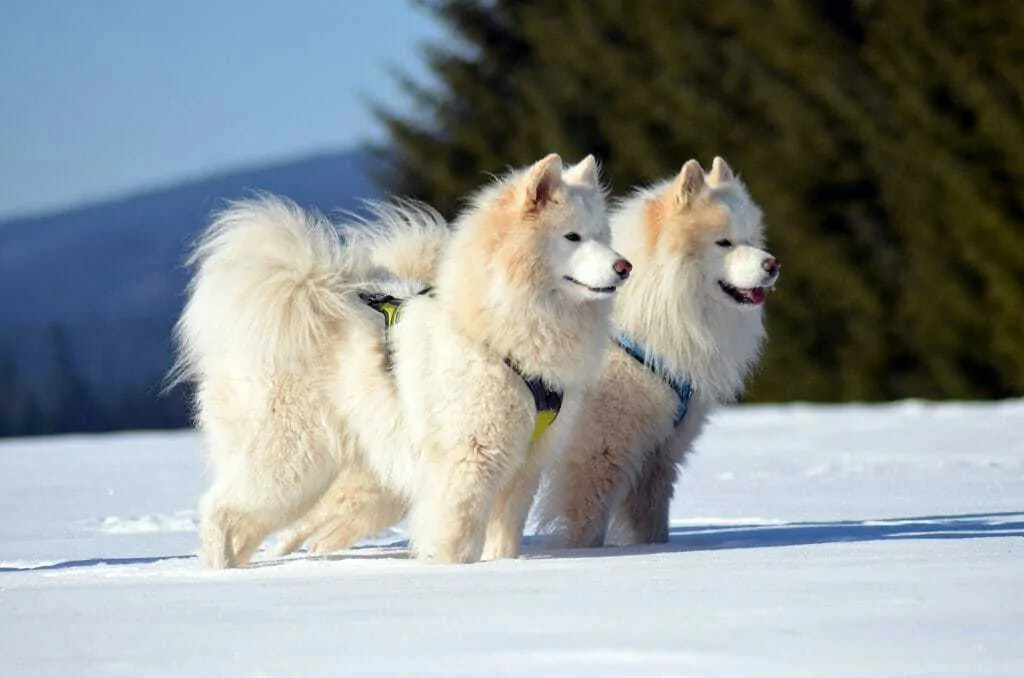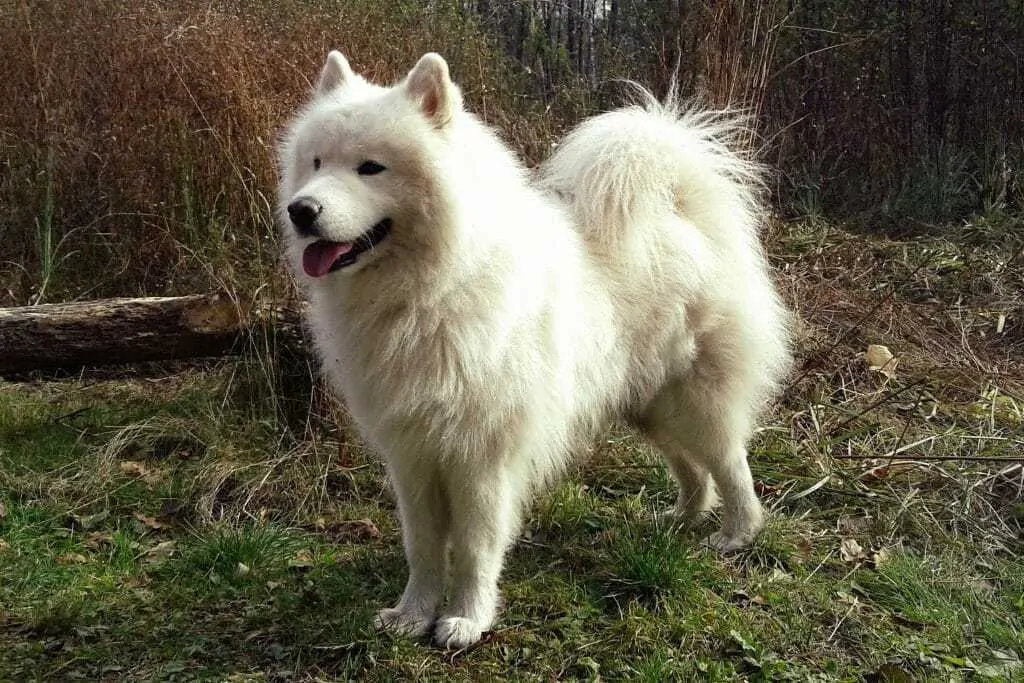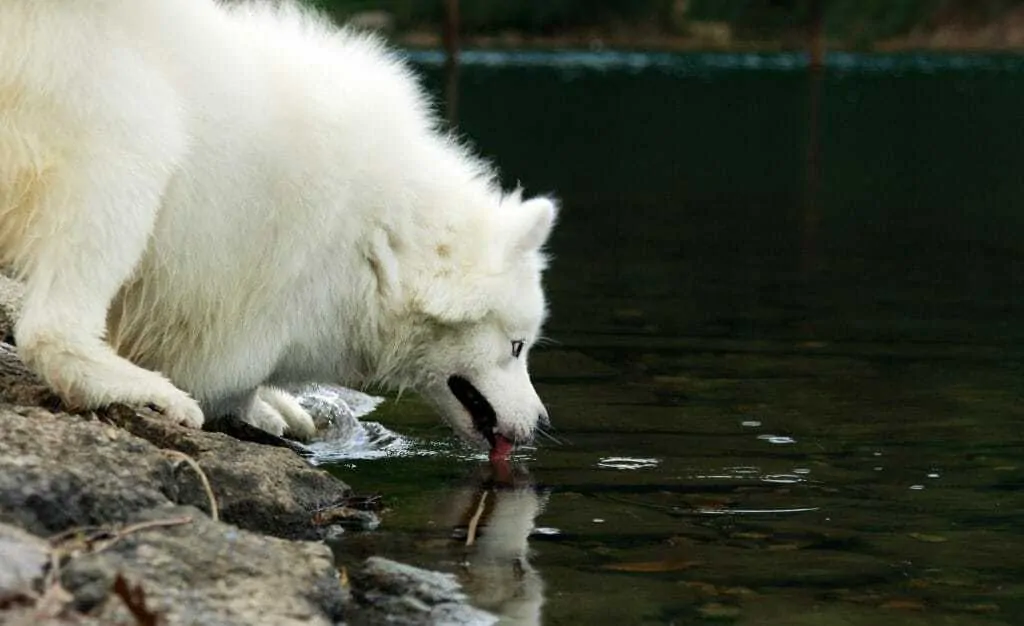The sight of a Samoyed, commonly referred to as Sammy, strikes the same reaction as that of seeing a new-born baby. Most people, particularly children, get an automatic need to want to pat a Sammy.
Given, the Samoyed is very adorable and has the loveliest personalities ever. But, it takes a lot to own a Samoyed, as most people come to learn. Hence, please do a lot of research if you are thinking of getting a Smiling Sammie.
The most outstanding feature of the Samoyeds is their lush white coat.
He stands out for his wedge-shaped head, fluffiness, naturally erect ears, and plumed tail, always gently wagging over his fluffy back. Behind all that lurks a fun-loving, smart, energetic dog. The Samoyed has many impressive qualities, but they are not right for everyone. We look at 15 things you should know about the Samoyed before owning one:
Contents
1. They had close associations with the Samoyede people
The samoyede people, currently known as the Nenetsky, bread and raised Samoyed dogs decades ago on the Taimyr Peninsula of Siberia.
They used Samoyed to pull sleds, hunt game, herd reindeer, and protect them against predators. In return, the samoyede people lived with these dogs, allowed them to play with their children, and kept them when in winter.
It was their closeness that helped create a sense of loyalty and trust in Samoyed dogs that remains to-date.
2. They Endured Terrible Hardships in the Early 20th Century
At the end of the 19th century, the Samoyed journeyed out of Siberia, and in the early part of the 20th century, they were used to pull explorer’s sleds on polar expeditions.
They were a big part of Sir Ernest Shackelton‘s remarkable exploration journey to the Antarctic. Around that time, only the strongest and fittest Samoyeds survive the terrible hardships they endured during such expeditions.
They also took part in the Antarctic and Arctic explorations of Scott, Nansen, and Amundsen. The wife of Edward VII, Britain’s Queen Alexandra, particularly favored them and went on to breed them. Her Samoyeds appear in the pedigrees of both the American and English Samoyed dog breed today.
Samoyeds prefer living in cooler temperatures.
3. Most People Mispronounce Their Name
The Samoyed’s name is often tricky for most people to pronounce. Most people tend to call these dogs precisely as the name is spelled “Sa-MOY-ed.” But the name should be pronounced as “Sam-a-YED.”
If you still find his name challenging to pronounce, I recommend just calling him Sammy. All Samoyed lovers do.
4. They are Good for Allergies
Dog lovers with cat or dog allergies, or people who in an unfortunate and strange turn of events find themselves suddenly allergic to dogs should consider looking for a Sammie.
This dog is an excellent companion to people allergic to a dog but would rather not settle for a hairless and yippy Montegomery Burns looking dog. People who just suddenly became allergic to dogs but grew up with Rhodesian Ridgebacks, Rottweilers, and Red Cattle dogs might suffice with a Sammie.
Samoyed produces surprisingly low dander amount, which is the key allergen in dogs and cats. Just to be sure, find someone who owns a Samoyed and spend some time with the dog just to be sure.
Samoyeds are known to be quite destructive and chewy when they are left alone for long periods of time.
5. Their Overall Grooming needs are High
Samoyeds are very, very fluffy. These dogs originated in Siberia’s cold weather, their double coat of fur is meant to insulate them when it’s cold as well as heat. However, those in hot climates need to make sure their Sammies get plenty of water and shade to avoid overheating.
Smiling Sammies’ owners should be prepared to spend around an hour every other night giving their Samoyeds a brush. With every brushing session, I recommend doing a good going over using a steel-toothed comb.
Brushing sessions for Samoyeds take about an hour minimum. It tends to get worse during spring because Samoyed shed their undercoat. During this period, Samoyed owners can even take two hours just to brush him.
You might have to brush hair off your furniture, rooms, and clothes every day. This is the case even for Samoyeds, who spend most of their time inside.
Samoyeds need baths at least once a month, for those who spend most of their time indoors. The good news, they are one of the dog breeds without the “dog smell,” which means they can get away with infrequent baths. The bad news, bathing Sammies can be quite a task.
Before bathing your Sammy, you have to brush and comb him first. Yes! That two-hour comb! Bathtub owners will find it easier to bathe Samoyeds. All you need to do us throw him into your bathtub with warm water. I recommend mixing the water with wool wash.
Before winding up the bath, take a bucket of water and a bit of doggy shampoo and scrub into her fur if you want him appropriately cleaned. Scrub into her fur and then cleanse her with clean, warm water.
Sadly, you will also have to blow-dry a Samoyed after his bath. The last thing you want is his fur to mat up and leave looking like he’s sporting dreadlocks. Finalize the bath with another brush. If I estimate right, it could take the best part of your weekend morning to bathe a Sammy.
Lucky for you, all that effort doesn’t go unrewarded. She will be looking like a beautiful, snuggly bear, and to top it all, that white fur doesn’t get as dirty as one would assume. Their furs repel dirt and can remain mostly white throughout a month.
Male samoyeds have thicker, denser coats than their female counterparts.
6. They are not Suitable for People who Hate Barkers
Samoyeds are well-known for their vocal range bark. Hence, people who don’t like loud barks should stay away from Sammies because they make all sorts of weird yet wonderful sounds.
They can be nuisance barkers. To effectively tackle this, I suggest that you start early as part of his training. I recommend trying the “speak on command” training. Even though you will grow accustomed to your Sammy’s sounds and all that, you must still keep an eye on this, especially if there is a chance of interacting with other people and animals.
7. They Love People
Samoyeds love people. This is mostly the deciding factor for Samoyed owners. They even laughing playing with kids. They are one of the few dog breeds you can leave a grown-up kid to play without much of a worry for either of their well-being.
You can find clips of kids on Youtube pulling at them, crawling over them, punching, kicking, pulling their hair, ears, tail, and more. These dogs met such playfulness with nothing but love. However, supervision is emphasized for any interaction between dogs and kids.
The downside of this is that Samoyeds are more prone to separation anxiety. If left alone constantly, they turn from Smiling Sammy to a lonely and destructive dog instead.
That said, this dog breed is not for those with no time to be around them much. The good news is, with a little training, you can leave him for hours at separate times, and there will be little to no issue.
People looking for a good guard dog, forget it. These dogs are not for you. Samoyeds love everyone; I mean everyone.
Even so, always have your Samoyed on a leash when you’re outdoors. They are still hunters at heart and won’t resist the urge to chase after small animals he perceives as prey. When he is not home in a fenced yard, leash him for both his safety and that of people around him.
Samoyeds are great in dog sports. They enjoy being active and always having something to do.
8. Their Exercise Needs are High
Samoyeds very active dogs, and they need daily exercise. Sammies need regular walks and a lot of attention from their owners. To maintain a well-trained Samoyed, you need to make sure they don’t experience mental or physical frustrations.
That said, they require a lot of physical and mental stimulation. Active play sessions, long walks, and a daily dose of one-on-one playtime with you will help keep your Sammy smiling and stimulated.
Because they enjoy having work to do, you can train him to be your walking, biking, jogging, or hiking companion, or bring the paper every morning. I recommend including him in dog sports like agility, weight pulling, or herding.
People in snowy areas will also find that Samoyeds enjoy snowshoeing, skijoring, and sledding. Whatever job or activity you give a Sammy, they do it with enthusiasm.
Tracking and agility are perfect activities to keep your Sammy mentally and physically stimulated.
9. They can be Challenging to Train
Samoyeds are independent thinkers. This makes training them a challenge. They get bored quite quickly, hence you need to keep the training sessions short, positive, and fun.
Sammies can benefit from formal puppy obedience training, given their intelligence. Samoyeds will try to dominate over you while they’re still puppies. Hence, you have to make sure they fully understand your commands, where to sit, and who the leader is.
They get bored fast, so you will also have to modify the training sessions. Make then constantly challenging if you don’t want your canine buddy to lose interest quickly after picking something up.
With patience and time, you can train them to be loyal and obedient dogs. You can also make them understand one-word commands if you keep using them all the time.
If possible, get your canine companion into kindergarten by the time he’s about 10-12 weeks old and socialize him as much as possible. I can’t emphasize the importance of early socialization for Samoyed puppies.
However, don’t take your Samoyed to a puppy training class until certain puppy vaccines, including rabies, parvovirus, and distemper, have been completed. Always make sure that the kennel cough vaccine is also up to date before taking him to puppy kindergarten.
Before he starts formal training, you can begin training your Sammy puppy at home and socializing her among your friends and family until she completes the vaccines. These experiences will help her grow into a more sensible, calm adult Samoyed.
Whatever traits you want in a Samoyed, look for a puppy whose parents have pleasant personalities and who were well socialized from puppyhood. You can do this by talking to your breeder, describe what you are looking for in a Sammy, and ask for help when choosing a Samoyed puppy.
Good breeders see the puppies daily, and just by knowing about your personality and lifestyle, they can make uncannily accurate puppy recommendations.
Sammies typically have calm temperaments. They can do well with kids and other dogs as long as they have been socialized from a young age.
10. They are among the Ancient Dog Breeds in the World.
There are 14 ancient dog breeds with genetic footprints resembling wolves, among them is Samoyed. They originated in Asia and belonged to the Spitz family. The people of Siberia then bred Samoyeds and treated them as family members rather than just possessions.
They first appeared in England in the late 19th century, mostly as gifts from the Czar of Russia. The first standard for the Samoyed dog breed was adapted in 1909 in England. The first Samoyed Club of American originated in 1923 and adopted the Samoyed American breed standard the same year.
11. They can Suffice with High-quality Dog Food
Sammies don’t need any special diet. Most Samoyeds are happy and healthy, eating high-quality home-cooked or commercial food. Make sure the high-quality diet has 22-24% protein and 12-15% fat.
Watch out for any signs of weight gain and make sure you distribute and limit his meals throughout the day, especially if you notice he has started to pack too many pounds.
If you notice uncontrolled weight gain in your puppy, gastric distresses, or potential food allergies, consult your vet about how to customize a diet plan that will work for your Sammy. In addition to meals, make sure to leave out plenty of freshwater for him.
Their weight should range between 50-65 lbs for males and 35-50 lbs for the female. Their height varies between 20-22 inches.
12. They do Have Some Common Health Issues
Similar to other purebred dogs, Sammies have some common health problems, though they are generally healthy dogs with a lifespan of 12-25 years.
Before buying a Samoyed puppy, make sure the breeder can present you with a complete health history of the puppy’s genetic line and health clearances of other conditions.
This will make it possible for you to know whether your Samoyed has a higher propensity of one of these common Samoyed health problems:
- Progressive Retinal Atrophy (RTA)
- Glaucoma
- Samoyed Hereditary Glomerulopathy – genetic kidney condition
- Hip Dysplasia
- Subvalvular Aortic Stenosis – blockage or obstruction in the dog’s blood flow to the heart
- Diabetes Mellitus
- Hypothyroidism
- Patellar Luxation
- Cancer
The average lifespan of samoyeds is 12-15 years.
13. They are Heat Sensitive
Their luxurious white fur coats prefer cold weather or chilly temperatures. Samoyed owners should never allow them to be overexposed in the heat.
Due to their heat sensitivity, schedule their exercise and play for cold or cooler hours of the evening or early morning. When it’s hot outside or when the temperatures heat up, keep him inside with air-conditioning.
14. They are Excellent with Children and Other Dogs
With early socialization and proper training, Samoyeds are good with kids and other dogs. However, supervision is recommended when there is an interaction between dogs and small kids.
They generally have calm temperaments, which is why they will do well around other dogs and pets, primarily if they have been raised together.
15. They are Famous for Their “Sammy Smile”
Samoyeds always wear their trademark grin. This is why their most common nickname is “Smiley.” The corner of a Samoyed’s mouths tends to turn upwards, giving him a happy expression. Hence, we call their smile the “Sammy Smile.”








